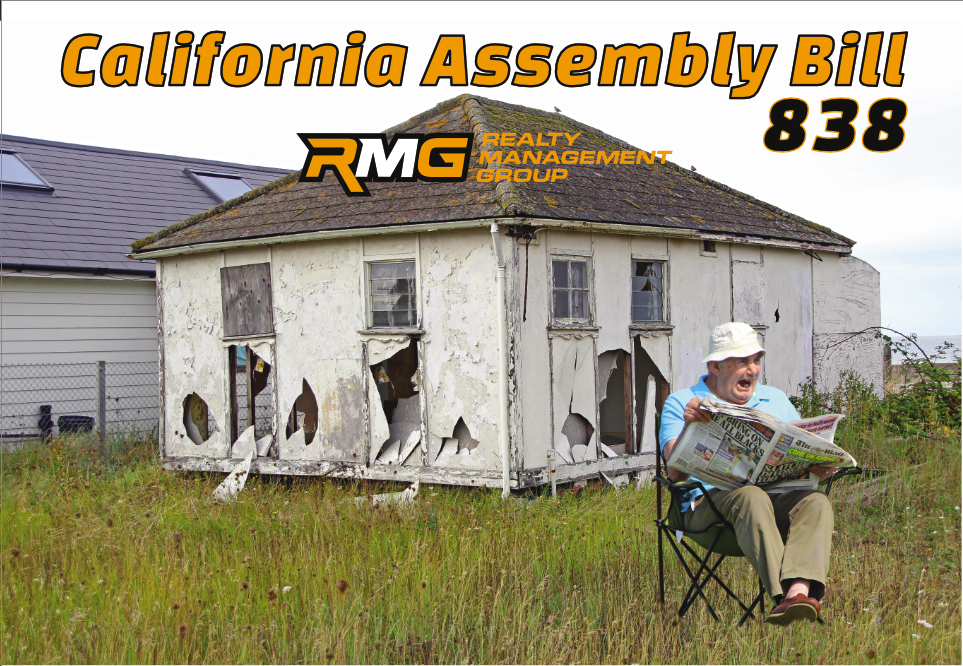California AB 838 Law: What Is It and Why Does It Matter?
If you have been renting your apartment or home in California, there is a possibility that you had no idea it was irreparably damaged. It's not because you are not doing a final walk-through before moving out, though; it's because you have been unaware of the hazardous conditions there. However, as tenants will soon find out, California has new legislation to protect them.
On September 29, 2021, California's legislature passed a new law, AB 838, in response to complaints by tenants of substandard building conditions. The Bill was published and shall become operative on July 1, 2022. This article will explain the purpose of the law and why it matters to those affected.
What is AB (Assembly Bill) 838?
AB 838 Code is a bill that tackles Enforcement in Property Management complaints from renters about lead hazards or other unsatisfactory building conditions. The following are examples of situations that render a building "substandard":
Pest infestations
Structural issues
Fire threats
Lack of heat
Lack of access to safe drinking water
Lack of exits
Section 17970.5 of the California Health and Safety Code, which was recently amended, will force municipalities to dispatch an inspector when a complaint is received. If there are any infractions, the city or county would be required to notify the landlord and spell out the necessary procedures to bring the property into conformity.
The rental unit will be reinspected to ensure that it is now habitable, rather than accepting the landlord's word that the problems have been resolved.
Many local governments already have their inspection programs in place. Still, AB 838 provides a stronger incentive for them to respond to complaints to nip problems in the bud and prevent a property's condition from deteriorating even further.
What Is the Purpose of the New Law?
AB 838 was created to protect California's tenants from hazardous and substandard conditions in their rental properties. The legislation will ensure that the government inspects the property and notifies the landlord to address any issues. It is a reminder for landlords about how important it is to maintain properties to meet all safety standards.
This is an excellent reminder for landlords to provide quality housing and meet the required regulations. Additionally, it should be noted that the tenant will also be receiving notification of any violations.
AB 838 law is a necessary step forward to ensure that all rental properties are safe for habitation and in compliance with the building code.
How Will It Affect Landlords?
Landlords in California are likely wondering how the new AB 838 law will affect them. Passed in response to complaints about substandard building conditions, the new law is meant to ensure that local governments respond more quickly and thoroughly to hazards in buildings. Unless the inspection reveals a lead hazard violation or the property is labeled substandard, the local authorities cannot charge the property owner for the review or report. This is a significant change from the current law, which requires that the local authority inspect every unit in every building before July 2022.
How Will It Affect Tenants?
Tenants are likely wondering how they will be affected by California AB 838 law. This vote of confidence in the landlord can be used to fight against a tenant's claim, but the landlord can go one step further and file their report alleging that the renter is to blame for the unsatisfactory conditions in the building.
Consider the case of a tenant who demonstrates hoarding behavior. There are problems with egress. It has built-up waste that smells bad and brings rodents to the area. The rental unit's condition is so awful that it has spilled over into the surrounding units. However, this is due to the tenant's neglect on their part. The renter is solely responsible for the state of the property in question.
Inspection Process
The local government will be responsible for notifying the landlord of each violation discovered and advising them on what needs to occur. The follow-up inspection makes sure that all requirements have been met, ensuring a safe living environment in which renters can enjoy their time spent at home or renting out properties.
Those who seek inspection reports and those whose hazard concerns have impacted will be entitled to get free copies of the information from their local governments.
Unless the findings of the inspection process result in violations, local governments are unable to collect fees associated with an inspection of a property.
Local Government Response to Building Hazards
Though it may seem like a recent issue, the problem of substandard buildings has been around for as long as people have been building them. In recent years, however, the number of complaints about hazardous facilities has skyrocketed, and lawmakers have noticed. This has led to a new law in California, AB 838, which is designed to speed up how local governments address these hazards.
Ideally, local government agencies responsible for responding to complaints about substandard buildings will be able to inspect buildings more quickly report their findings to the government body, which can use that information to take action against property owners. If the building is unsafe, property owners will have little choice but to comply with any directives from the local government before they are given a deadline.
AB 838 law in California has been highly anticipated by tenants and housing advocates who want better protection for their health and safety. With the severe housing shortage in many parts of California, landlords are often under pressure to delay necessary maintenance procedures while waiting for assistance from city inspectors. Hopefully, this new law will allow local governments to provide more support to tenants while enforcing existing codes faster.
Conclusion
Keeping a rental apartment in livable shape is a joint responsibility that involves both the landlord and the tenant.
Even though it is widely acknowledged that the property does not have to be in perfect condition, the landlord is still responsible for ensuring that the building meets minimum safety standards such as adequate heating, effective waterproofing, plumbing and gas facilities, properly maintained stairs, and common areas, among a host of other responsibilities. On the other hand, the renter is responsible for keeping the rental property in a livable condition.







